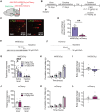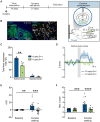An endogenous GLP-1 circuit engages VTA GABA neurons to regulate mesolimbic dopamine neurons and attenuate cocaine seeking
- PMID: 40009667
- PMCID: PMC11864183
- DOI: 10.1126/sciadv.adr5051
An endogenous GLP-1 circuit engages VTA GABA neurons to regulate mesolimbic dopamine neurons and attenuate cocaine seeking
Abstract
Recent studies show that systemic administration of a glucagon-like peptide-1 receptor (GLP-1R) agonist is sufficient to attenuate cocaine seeking. However, the neural mechanisms mediating these effects and the role of endogenous central GLP-1 signaling in cocaine seeking remain unknown. Here, we show that voluntary cocaine taking decreased plasma GLP-1 levels in rats and that chemogenetic activation of GLP-1-producing neurons in the nucleus tractus solitarius that project to the ventral tegmental area (VTA) decreased cocaine seeking. Single-nuclei transcriptomics and FISH studies revealed that GLP-1Rs are expressed primarily on GABA neurons in the VTA. Using in vivo fiber photometry, we found that the efficacy of a systemic GLP-1R agonist to attenuate cocaine seeking was associated with increased activity of VTA GABA neurons and decreased activity of VTA dopamine neurons. Together, these findings suggest that targeting central GLP-1 circuits may be an effective strategy toward reducing cocaine relapse and highlight a functional role of GABAergic GLP-1R-expressing midbrain neurons in drug seeking.
Figures







Update of
-
An endogenous GLP-1 circuit engages VTA GABA neurons to regulate mesolimbic dopamine neurons and attenuate cocaine seeking.bioRxiv [Preprint]. 2024 Jun 24:2024.06.20.599574. doi: 10.1101/2024.06.20.599574. bioRxiv. 2024. Update in: Sci Adv. 2025 Feb 28;11(9):eadr5051. doi: 10.1126/sciadv.adr5051. PMID: 38979354 Free PMC article. Updated. Preprint.
Similar articles
-
An endogenous GLP-1 circuit engages VTA GABA neurons to regulate mesolimbic dopamine neurons and attenuate cocaine seeking.bioRxiv [Preprint]. 2024 Jun 24:2024.06.20.599574. doi: 10.1101/2024.06.20.599574. bioRxiv. 2024. Update in: Sci Adv. 2025 Feb 28;11(9):eadr5051. doi: 10.1126/sciadv.adr5051. PMID: 38979354 Free PMC article. Updated. Preprint.
-
GLP-1 receptor signaling in the laterodorsal tegmental nucleus attenuates cocaine seeking by activating GABAergic circuits that project to the VTA.Mol Psychiatry. 2021 Aug;26(8):4394-4408. doi: 10.1038/s41380-020-00957-3. Epub 2020 Nov 30. Mol Psychiatry. 2021. PMID: 33257815 Free PMC article.
-
Glucagon-Like Peptide-1 Receptor Activation in the Ventral Tegmental Area Decreases the Reinforcing Efficacy of Cocaine.Neuropsychopharmacology. 2016 Jun;41(7):1917-28. doi: 10.1038/npp.2015.362. Epub 2015 Dec 17. Neuropsychopharmacology. 2016. PMID: 26675243 Free PMC article.
-
Dopamine neurons gate the intersection of cocaine use, decision making, and impulsivity.Addict Biol. 2021 Nov;26(6):e13022. doi: 10.1111/adb.13022. Epub 2021 Feb 8. Addict Biol. 2021. PMID: 33559379 Review.
-
Central GLP-1 receptors: Novel molecular targets for cocaine use disorder.Physiol Behav. 2019 Jul 1;206:93-105. doi: 10.1016/j.physbeh.2019.03.026. Epub 2019 Mar 28. Physiol Behav. 2019. PMID: 30930091 Free PMC article. Review.
Cited by
-
Curbing the appetites and restoring the capacity for satisfaction: The impact of GLP-1 agonists on the reward circuitry.Neurosci Appl. 2025 Mar 3;4:105512. doi: 10.1016/j.nsa.2025.105512. eCollection 2025. Neurosci Appl. 2025. PMID: 40654594 Free PMC article. No abstract available.
-
Mechanistic and translational insights from preclinical cocaine choice procedures on the economic substitutability of cocaine and nondrug reinforcers.Neurosci Biobehav Rev. 2025 Aug;175:106217. doi: 10.1016/j.neubiorev.2025.106217. Epub 2025 May 21. Neurosci Biobehav Rev. 2025. PMID: 40409443 Review.
-
Mechanisms of GLP-1 in Modulating Craving and Addiction: Neurobiological and Translational Insights.Med Sci (Basel). 2025 Aug 15;13(3):136. doi: 10.3390/medsci13030136. Med Sci (Basel). 2025. PMID: 40843757 Free PMC article. Review.
-
GLP-1 Analogues in the Neurobiology of Addiction: Translational Insights and Therapeutic Perspectives.Int J Mol Sci. 2025 Jun 1;26(11):5338. doi: 10.3390/ijms26115338. Int J Mol Sci. 2025. PMID: 40508146 Free PMC article. Review.
References
-
- Kariisa M., Davis N. L., Kumar S., Seth P., Mattson C. L., Chowdhury F., Jones C. M., Vital signs: Drug overdose deaths, by selected sociodemographic and social determinants of health characteristics - 25 states and the district of Columbia, 2019-2020. MMWR Morb. Mortal Wkly. Rep. 71, 940–947 (2022). - PMC - PubMed
MeSH terms
Substances
Grants and funding
LinkOut - more resources
Full Text Sources
Medical

